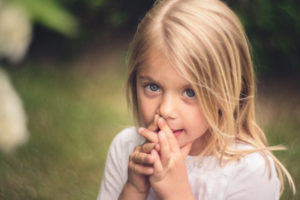Photo Credit: Anais CCLicense
How do you help your child manage anxiety?
This is the topic that I discussed with a group of parents from Larson Elementary last night, and it was exciting to hear that their school is already implementing anxiety prevention programs such as Mind Up and F.R.I.E.N.D.S.
Anxiety is a natural human reaction to stressful situations and can be useful as a motivator or to activate the “fight or flight” response. Anxiety becomes a significant concern when it begins to interfere with the normal daily functions in a child’s life. Untreated anxiety greatly increases the risks for depression, suicide, decreased motivation and lower educational and work success. If you suspect that your child has a high degree of anxiety, it is important to educate oneself and seek professional advice from your doctor, counsellor, psychologist, or psychiatrist.
Facing the Fear
When something makes us anxious, our first reaction is to avoid having the experience again. However, avoiding the cause of the anxiety can actually make it worse. It becomes a pattern to reinforce avoidant behaviour without meaning to. It is important to face the trigger and this can be done in a systematic way. For example, if a child is scared of dogs, you could find a dog that is really friendly and docile, and set up a schedule for visiting the dog on a regular basis. The first step could be to walk over to the dog, and look at it from a distance. The next day your child could be encouraged to move a little closer. With each visit, the goal would be to have your child move towards the ultimate goal of being able to pet the dog. It would also be very important to give your child lots of praise and encouragment to positively reinforce your belief in your child’s courage and his/her actions for overcoming the fear.
Desensitizing your child to an anxiety producing experience, is called EXPOSURE, and this is a very important component in helping your child learn how to manage his/her anxiety. Flooding is another form of creating exposure but is a shorter and more intense process. For example, if your child was fearful of starting swimming lessons and the unknown factor of not knowing who the teacher was going to be, you could remind your child of all the positive experiences he/she has had in the swimming pool, reassure him/her that you are going to be there to introduce him/her to the new teacher and that you will be in the viewing area watching the lesson. Your child may be upset for the first five minutes but then the wave of anxiety would probably pass and he/she would be able to enjoy the lesson. For younger children, the separation may be too much, and you may need to continue with the parent/child lessons until they are a little older.
Learning to Relax
Another important piece of learning to manage anxiety is knowing how to RELAX oneself. Relaxation exercises need to be practiced daily in order that they can be utilized, with familiarity, when one is anxious. There are many forms of relaxation from parent-child yoga to meditation to bed-time relaxation routines. At home, you can teach your child how to take big, deep breaths while counting, or saying words such as RE-LAX, HA-PPY, Feel Calm, OK-AY – breathe in on the first word or syllable and out on the second. Progressive muscle relaxation is another method that creates endorphins in the body which combat the cortisol hormones created by the stress. In progressive muscle relaxation, the goal is to tense all the muscles in the body (squeeze hands, shoulders, arms, tummy, legs, feet) like a robot and then let it all go like a floppy rag doll. Repeat this exercise at least three times. *Remember you can’t be stressed and relaxed at the same time!
Cognitive Behavioural Therapy (C.B.T)
The third component for managing anxiety is incorporating Cognitive Behavioural Therapy (C.B.T). Cognitive Behavioural techniques teach one to use positive self-talk, re-frame, distinguish helpful thoughts from unhelpful thoughts, use logic to challenge negative thinking, and create images for containing worries. My favourite book that I use to teach children these techniques is called What to Do When You Worry Too Much by Dawn Heubner.
Tips for Managing Anxiety
Lastly, I am including two downloadable pages titled: 10 Tips for Managing Anxiety
For those of you who are reading this and were at my presentation last night, I’d love to hear your comments. Please feel free to use the comment section at the end of this page and to forward this article to any friends or family members who may find this information useful.
Warmly,
Want to Connect?
Subscribe now to receive free weekly parenting tips and inspiration.









2 thoughts on “Helping Your Child Manage Anxiety”
Comments are closed.